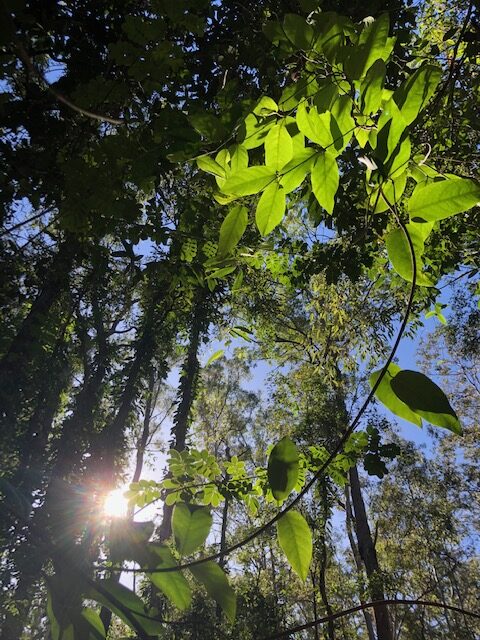
How Komorebi Can Help You Find Awe And Illuminate Your Inner Shadows
There is a word in Japanese language – komorebi. It is made up of the characters for tree, shine through, and sun. An eloquent word, komorebi rolls off the tongue in a much more poetic way than the English equivalent of ‘dappled light shining through the forest canopy’.
Finding awe in komorebi
Komorebi is a phenomenon that never fails to invoke the feeling of awe, at least that’s my experience. I love the depth of contrast caused by komorebi in early mornings and late afternoons when the sun is low in the sky. The burst of sunrays finding their way through thick canopy, or the contrast in colours of vibrant green leaves backlit against muted-shades of green.
Sometimes on bushwalks I am stuck in my head, ruminating over a worry, trying to solve a problem, or just simply distracted. Then I catch sight of a backlit fern or vine and it grabs my attention. For a moment I’m out of my pre-occupation and instead joyfully caught up in an appreciation of colour and light. I’m in a state of awe. I’m transcending my self. I am part of something bigger than me.
In recent years the science of awe has become a topic of study. We may think about awe and our mind grabs on the big moments – like seeing thousand-year old rice terraces, or witnessing the birth of a baby. However, researchers are bringing to light the importance of finding awe in the little things, and especially in nature. For example, a conscious noticing of komorebi and the awe it invokes. Not only does it make us feel wonder, but it has a flow-on effect to other positive feelings such as joy and gratitude. Noticing awe has even been shown to increase satisfaction in life.

Bringing light into our human experience
Humans are intrinsically linked with nature – we are nature, we come from nature – and there are many lessons we can observe in nature and bring into our own human experience.
Komorebi is one such lesson. When I learnt about this word, komorebi, it got me thinking about the interplay of light and shadow in our own lives.
As we go through life, we walk in the shadows as well as the light. The shadows can represent our fears, doubts, judgements etc. When we’re able to shine a light on these shadows – and by that I mean have an awareness of them – they can be seen, inquired upon and in time, released. The illumination phase brings awe and beauty to the inner self, as we understand our inner strength, power and capability.
We understand the shadows represent thoughts, and thoughts are just illusions – not truth – that are shattered by illumination. We find that through this illumination, the shadow is no longer something to be feared.
We can then walk, in ease and peace, knowing that in our human emotional and psychological make-up, our natural state of being is akin to a dappled forest. To be awe-struck by a metaphorical komorebi – the beauty of light bursting through – we first need to walk among the shadows. This is what makes life such a meaningful and sacred journey.
"To appreciate our light, first we must know our shadow. Komorebi represents hope - a hope that light will find its way."
Cherie Pasion
Cherie Pasion
Cherie Pasion is the founder of Connection Compass, providing coaching for women wanting to live a connection-filled life. A certified life coach and behaviour change specialist, Cherie has run award-winning behaviour change programs helping thousands of people across Australia. Cherie holds a Master of Social Science, Bachelor of Business, and Diplomas of Neuro Linguistic Programming and Shinrin Yoku (Forest Bathing). Cherie is also an internationally-published author.Sign up for our newsletter
Let's connect
Connection Compass acknowledges the Turrbal and Jagara people, the Traditional Custodians of the land on which we work, live, and gather. We pay our respect to Elders past, present and emerging, and draw inspiration from their connection to Country, community and spirit.


